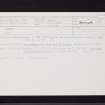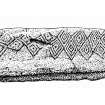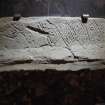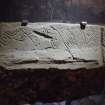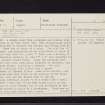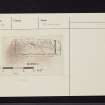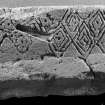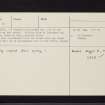Badden
Cist (Bronze Age), Unidentified Flint(S) (Flint)
Site Name Badden
Classification Cist (Bronze Age), Unidentified Flint(S) (Flint)
Canmore ID 39384
Site Number NR88NE 17
NGR NR 8582 8904
Datum OSGB36 - NGR
Permalink http://canmore.org.uk/site/39384
- Council Argyll And Bute
- Parish Kilmichael Glassary
- Former Region Strathclyde
- Former District Argyll And Bute
- Former County Argyll
NR88NE 17 8582 8904.
NR 858 890. A single slab from a grooved and rebated cist was ploughed up on 18th March 1960. It was presented to Glasgow Art Gallery and Museum (Accession no: A 6045). There was no trace of a cairn. The slab lay 10" below ground, and excavation at the site found no trace of a cist, but sunk into the gravel 1' down, was a setting of rounded boulders covering an area 17 x 8' and extending to 2' below present ground level. Among the boulders were patches of dark earth with small deposits of charcoal, and some dressed flints, including a scraper. The site suggested a dwelling site rather than a grave. A number of dressed flints - some water-rolled - and struck cores were also found on the surface of the field between the site and the Badden Burn to the SW. A local informant stated "a flat stone like a small hatch-cover" (cist slab ?) had been found higher up the field about 30 years before, but it was re-buried by the farmer who feared it might be a gravestone. There was no mention of this slab having been carved.
M Campbell, J G Scott and S Piggott 1963.
NR 8582 8904. Mr Campbell indicated the area of the find spot on the ground. Nothing else of interest has since been found in this ploughed field.
He also considered that the other slab was found at NR 859 890, in an unploughed part of the field, during draining.
Visited by OS (D W R) 11 June 1973.
Field Visit (October 1985)
In 1960 the side-slab of a cist was discovered in the course of ploughing at a point about 300m SE of Badden farmhouse and at a depth of 0.25m; no other slabs were found and there was no indication of the contents of the cist (Campbell and Sandeman 1963; 1964). The slab measures l.53m by 0.55m and 0.08m in thickness and is decorated on the upper part of what has been its inner face with double and triple lozenge motifs; these are slighted at each side by pecked grooves (50mm wide and 20mm deep and about 170mm from the right edge of the slab and 130mm from its left edge), which originally were designed to accommodate the end-slabs of the cist. The bottom edge of the slab has been dressed in order to allow a smooth fit with a basal slab. The stone is in Glasgow Art Gallery and Museum.
Excavations at the time of the discovery revealed an area of boulders 5.2m by 2.4m in extent with some deposits of charcoal and worked flint, but the interpretation of this setting is uncertain. There is a local report that another flat slab had been found in the field some thirty years earlier, but there need be no connection between the discoveries.
Visited October 1985
RCAHMS 1988
















